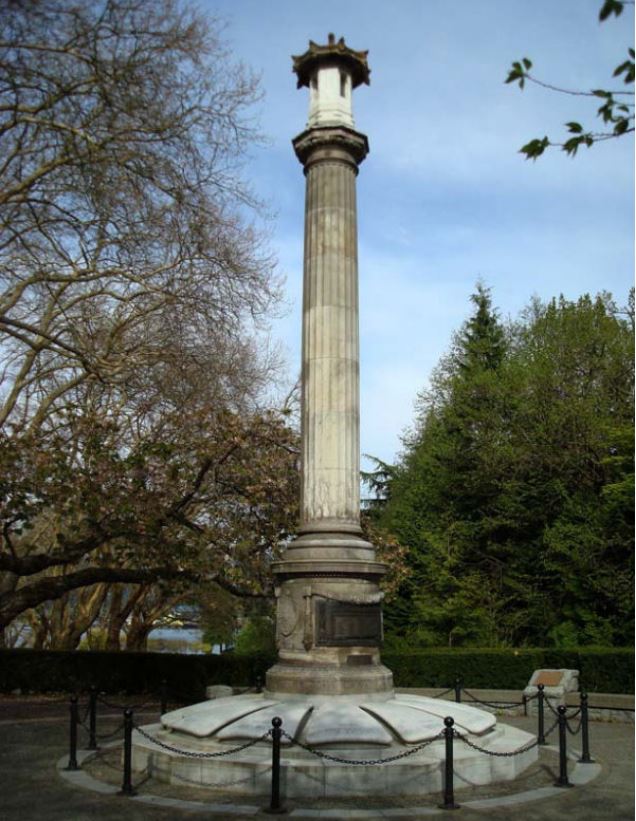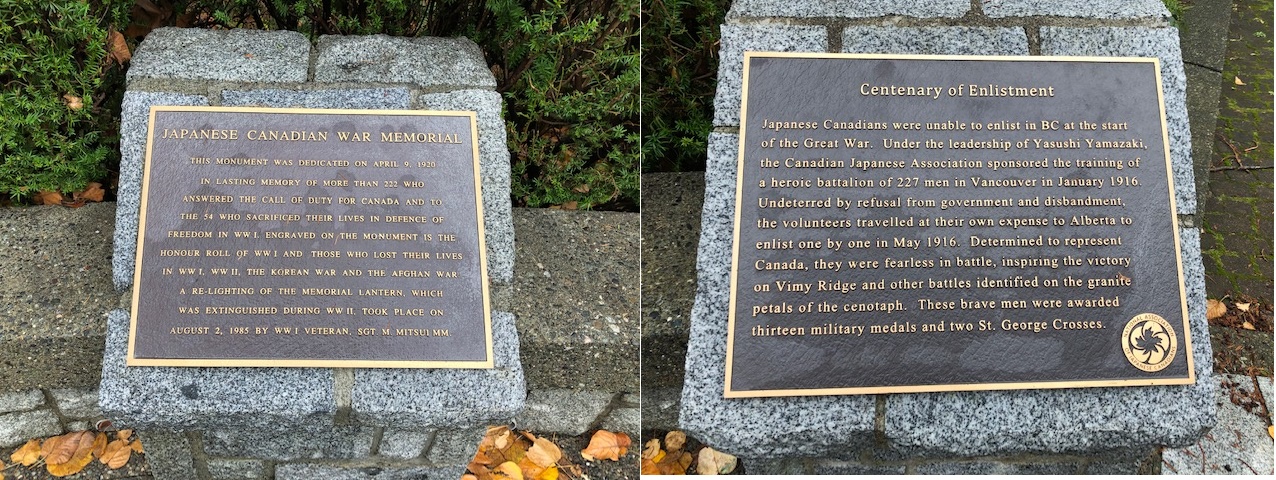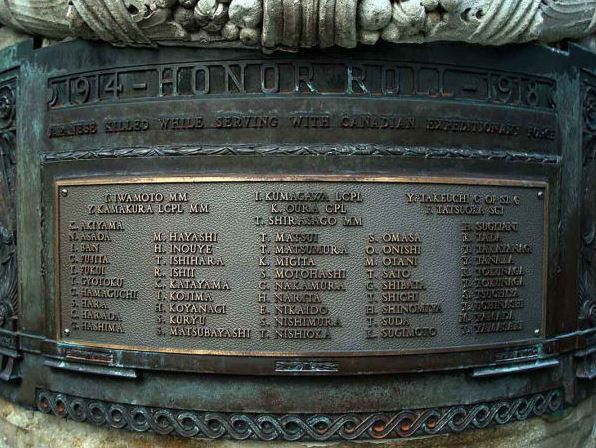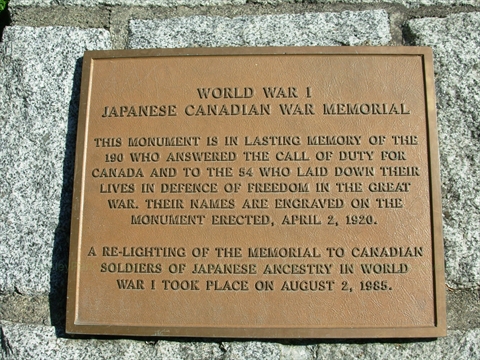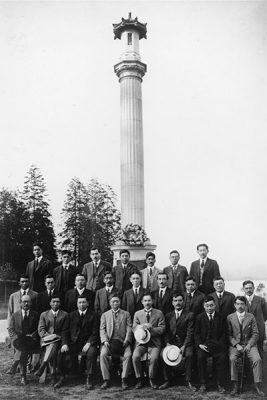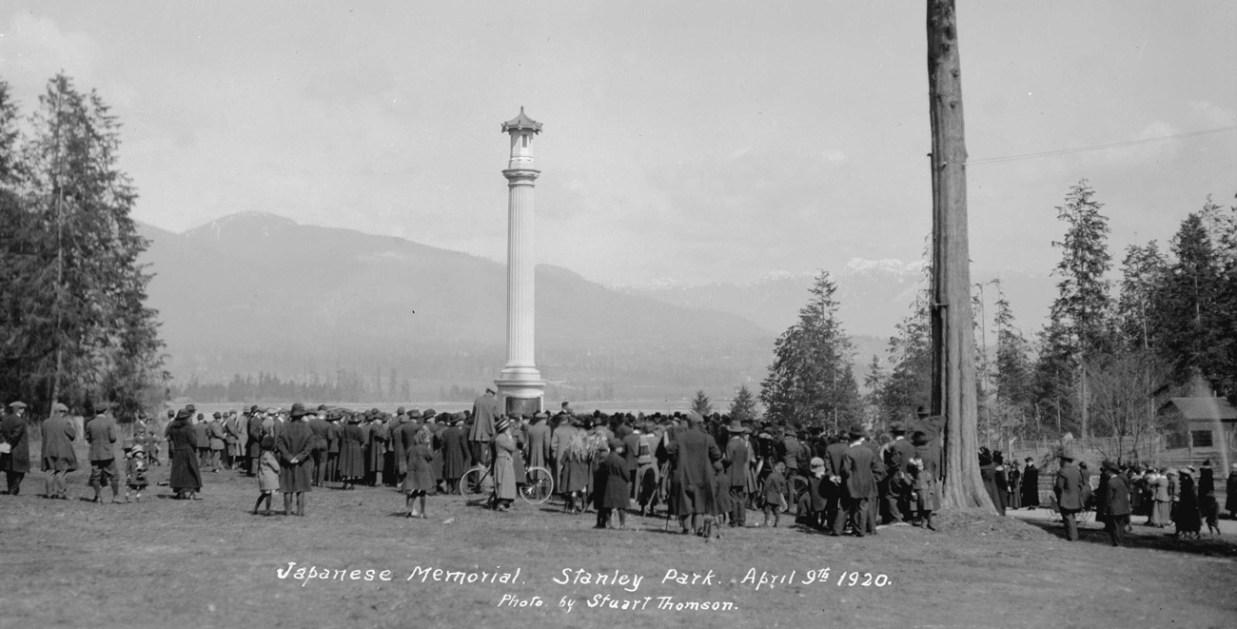The Japanese Canadian War Memorial was funded by the community and dedicated on April 9, 1920, the third anniversary of the opening day of the Battle of Vimy Ridge. The Canadian Japanese Association, who also funded the training of 227 soldiers in Vancouver from January to May 1916, erected the memorial in memory of the victory at Vimy Ridge, the loss of 54 men and the 168 surviving Japanese Canadian Veterans who returned to Canada.
The memorial was placed on gravel in an open field. It was designed by James Anderson Benzie in 1919. On top of the memorial is a Japanese lantern which symbolizes unification between Canada and Japan. The lantern is reminiscent of the ancient Kasuga lanterns at the great shrine at Kyoto, albeit on a larger scale. At the top of the fluted classical central column is a Shinto pagoda form containing the lantern. The 12 “polygons” of the base suggest radiating chrysanthemum petals, emblematic of the Japanese imperial family, but also a symbol of lamentation or grief.
After the memorial was dedicated, cherry trees were planted, including the shirofugen in 1920, ojochin in 1925, and shirotae in 1932. The cherry trees serve many symbolic interpretations that relate to the fallen soldiers. On May 10, representatives of the Japan Society of Vancouver, the Canadian Japanese Society, the Japanese Consulate, and the Park Board dedicated additional flowering cherry trees. In 1958, as a symbol of the friendship between Canada and Japan, 300 additional cherry trees were donated by the Japanese consul Muneo Tanabe. In 1977, two of the last surviving Japanese Canadian Veterans of the First World War planted akebono cherry trees at the memorial.
In addition to differences of colour, the cherries selected for the memorial displayed a variety of tree shapes. They also follow a different blooming sequence. The ojochin tree displays evidence of manipulation through the Japanese art of niwaki entailing the pruning, training, and shaping of trees. The tree was trained in the manner of the flowing or streaming branch style of giant bonsai practice, known as Nagare Eda Shitate, and its horizontal orientation specifically suggests the Monkan Shitate, or Branch-Over-Gate form of niwaki. The training of the tree to form an arch of flowering cherry blossoms extending virtually to the monument has produced a canopy that completely envelops visitors standing on the west side of the memorial with cherry blossoms in the spring.
Its landscape incorporates symbols of regeneration of traumatized humanity reinforcing the remembrance and reverence for the war dead. Drawing on trees as powerful symbols of identity and renewal, it offered solace and healing to survivors and it holds the potential to continue to resonate with visitors who have been made aware of the profound messages this landscape was intended to convey.
Among the more remarkable features of the landscape is the relationship of the seasonal cycle to traditions of honouring the war dead. The cherry trees bloom every year around the time of the anniversary of the dedication of the Japanese Canadian War Memorial on 9 April 1920, and of the Battle of Vimy Ridge on the same date in 1917. Almost as quickly as they bloom, the cherry blossoms wither and fall off the trees, symbolic of the fleeting character of life. Yet the foliage and blossoms of the trees return every year in a perpetual renewal of life in the spring. This landscape speaks eloquently to the devotion of Japanese Canadians to the memory of the brave soldiers who fought and died on behalf of their compatriots, and the obligation of survivors to honour their service and sacrifice through these moving symbols of death and restored life.
During the Second World War, the lantern was extinguished. Canada detained 21,000 Japanese-Canadians living in BC under the War Measures Act. Their homes and businesses were sold by the government to pay for their detention. The lantern was not relit until August 2, 1985. In a ceremony, 98 year old Sergeant Masumi Mitsui, who served in the First World War and fought in the Battles of Vimy Ridge and Hill 70, relit the lantern. Sergeant Mitsui was awarded a Military Medal for his leadership at Vimy and Hill 70. The monument was restored and a fence was built around the monument.
The Japanese Canadian War Memorial Committee has subsequently added the names of Japanese Canadians who died in the Second World War, Korean War and Afghanistan.
In October 2014, the memorial was refurbished, the dedication plaque was replaced, the limestone polished white and the petals on the base cleaned. In February 2015, with funding from Heritage BC's Heritage Legacy Fund, cracks on the marble lantern were filled in and the glass windows were replaced with custom made panes to match the design of their originally established era. The Centenary of Enlistment was installed in 2016.
Today, the cherry blossom trees have grown out and the monument is enclosed by a chain link and a tidy, cement flooring.
